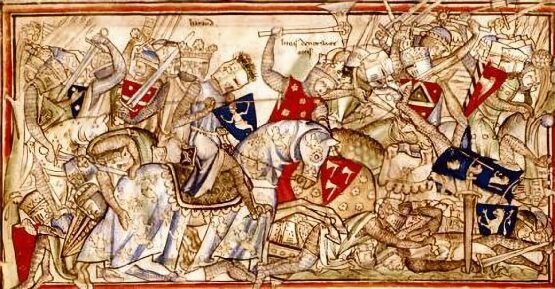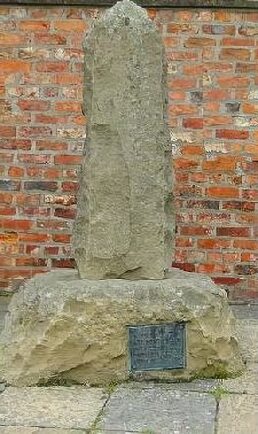25th September, 1066
There were several claimants to England's throne on the death of the childless King Edward The Confessor of England, who was succeeded by his brother-in-law, Harold Godwineson, who was chosen by the Witan, in January of the eventful year of 1066. These claimants included Harald Hardrada, ("harðráði" in Old Norse, meaning "hard ruler") King of Norway, who assembled a fleet of 300 ships, probably carrying about 15,000 troops, to invade England and make good his claim.
Harold Hardrada
A renowned warrior, Harald Hardrada was described by Snorri Sturluson to have been "larger than other men and stronger". He was said to have had light hair and a beard and moustache, one of his eyebrows were situated somewhat higher than the other. He was also reported to have had large hands and feet and was rumoured to be seven feet tall.
Hardrada arrived off the English coast in September, where his army was reinforced by Tostig Godwineson, the unruly and discontented brother of Harold, at the head of forces from Flanders and Scotland.
Tostig was bitterly opposed to his elder brother Harold, following a revolt in 1065 against his rule as Earl of Northumbria. Harold had removed him from his position and exiled him. Tostig had taken refuge with his brother-in-law, Count Baldwin V of Flanders, the father-in-law of William of Normandy and was now bent on vengeance. He had travelled to the court of Harald Hardrada and persuaded him to invade England.
In the late summer of 1066, Hardrada and Tostig landed at Tyne, they proceeded to sack and burn the town of Scarborough and sailed up the River Ouse before advancing on the city of York. They defeated an Anglo-Saxon army sent to meet them under the command of Edwin, Earl of Mercia and his brother Morcar, Earl of Northumbria at the Battle of Fulford on 20th September, after which York surrendered and hostages were demanded from the Northumbrians. They then sailed down the Humber and disembarked at Riccall.
King Harold was waiting in the south of England, in expectation of William of Normandy's pending invasion, William claimed the throne had been promised to him by his cousin Edward the Confessor. News arrived of the Viking attack and Harold hurried north with his housecarls and as many thegns as he could muster.
Continuing to travel both day and night, Harold marched his army relentlessly from London to Yorkshire, a distance of about 185 miles, in only four days, which enabled him to take the Norwegians completely by surprise.
Learning that the Northumbrians had been ordered to send hostages and supplies to the Vikings at Stamford Bridge, seven miles to the east of York. Harold advanced to attack them at this rendezvous point. No forces had been left at York, enabling Harold to march right through to Stamford Bridge. Hardrada, possibly assuming that King Harold would not leave the south of England under threat of a Norman invasion, confidently left a third of his men and armour at their base camp at Riccall, on the River Ouse, before approaching Stamford Bridge.
At a parley before the battle, Harold offered his brother, Tostig, his earldom back if he would lay down his arms and join him, Tostig asked what English lands Harald Hardrada could expect if he dismissed his Viking army. King Harold replied that 'he would offer Harald seven foot of good English soil, or as much as he needed as he was taller than other men'.
The Viking army, caught unaware by the English, was divided, with some of their troops positioned on the west side of the River Derwent and the bulk of their army on the east side. The 25th September 1066, was a warm day, for the time of year, which had led to the Vikings to leave their byrnies (a mail shirt reaching the mid-thigh) at their ships, placing them at a distinct disadvantage in the following battle.
The Battle of Stamford Bridge
By the time the main English army had arrived at the scene, the Vikings on the west side of the river had either been killed or were fleeing across the bridge. The English attempted to follow across the bridge but were delayed by the need for the army to pass through the bottle neck presented by the bridge itself.
A huge Viking berserker clutching a massive double-bladed great axe blocked this narrow crossing, single-handedly holding up the entire Saxon army. The Anglo-Saxon Chronicle records that he slew up to 40 Englishmen. He was finally defeated when an Anglo-Saxon soldier floated under the bridge in a half-barrel and thrust his long spear through the laths in the bridge, mortally wounding him.
The delay created by the beserker had allowed time for the bulk of the Viking army to form a shield wall, in the shape of a triangle against the English attack. The Anglo-Saxon army poured across the bridge and formed a line just short of the Vikings, they then locked shields and charged. The battle was fierce and bloody and raged for hours.
Eventually, the Viking army began to fragment and fracture, allowing the English to break in through the shield wall. The fierce fighting continued throughout the afternoon. The massive Viking king Hardrada, who, according to the sagas, wore a blue tunic and helmet and wielded a two-handed sword, advanced ahead of his army and in true beserker style, dealt devastating blows to all around him. As dusk drew near, he was killed by an arrow to his windpipe. Tostig took up the fallen Viking Raven Banner, "Land-Ravager" and continued to rally the troops and fight on but was himself slain.
Monument to the Battle
The Vikings left behind to guard the ships at Ricall, led by Eystein Orri, Hardrada's daughter's fiancé and fully armed for battle, arrived on the scene and plunged into the melee. Their counter-attack, described in the Viking tradition as "Orri's Storm", briefly held up the English advance, but was soon overwhelmed and Orri himself was slain by a Saxon warrior as darkness fell on the battlefield.
Without a leader around which to rally, the battered remnants of the Norse invasion force broke. The routed Viking army was pursued by the English, some of the fleeing Norsemen were drowned in the rivers.
The location of the initial action, for control of the bridge, has been securely located. The exact location of the main battlefield at Stamford Bridge is however difficult to determine, given the lack of landscape description in the available sources. The area called 'Battle Flats' to the south-east of the town is generally accepted as the correct location
So many died in a small area that the field was said to have been still whitened with bleached bones 70 years after the battle. Harold accepted a truce with the survivors, who included Hardrada's son Olaf and Paul Thorfinnsson, Earl of Orkney. They were allowed to leave peacefully after pledging not to attack England again.
Of the approximately 200 ships the Vikings arrived with, only around 25 were needed to return the survivors to Norway. They withdrew to Orkney, where they spent the winter, and in the spring Olaf returned to Norway. Tostig's body is believed to have been taken to York and buried at York Minster. A year later, Hardrada's body was moved to Norway and buried at the Mary Church in Nidaros (Trondheim).
Harold's victory was, however, short-lived, while celebrating his victory at a banquet in York, he received news that William of Normandy had landed in Sussex on the south coast of England and hurried south to meet him, where he was defeated and killed at the Battle of Hastings on 14th October. The fact that Harold had to make a forced march to fight Hardrada at Stamford Bridge and then move at speed south to meet the Norman invasion, all in less than three weeks is widely seen as a primary factor in William's victory at Hastings.
Following his death at Stamford Bridge, it is thought that Tostig's body was taken to York for burial at York Minster. His two sons took refuge in Norway, while his wife Judith remarried to Duke Welf of Bavaria.
The Battle of Carham PreviousNext The Battle of Hastings
